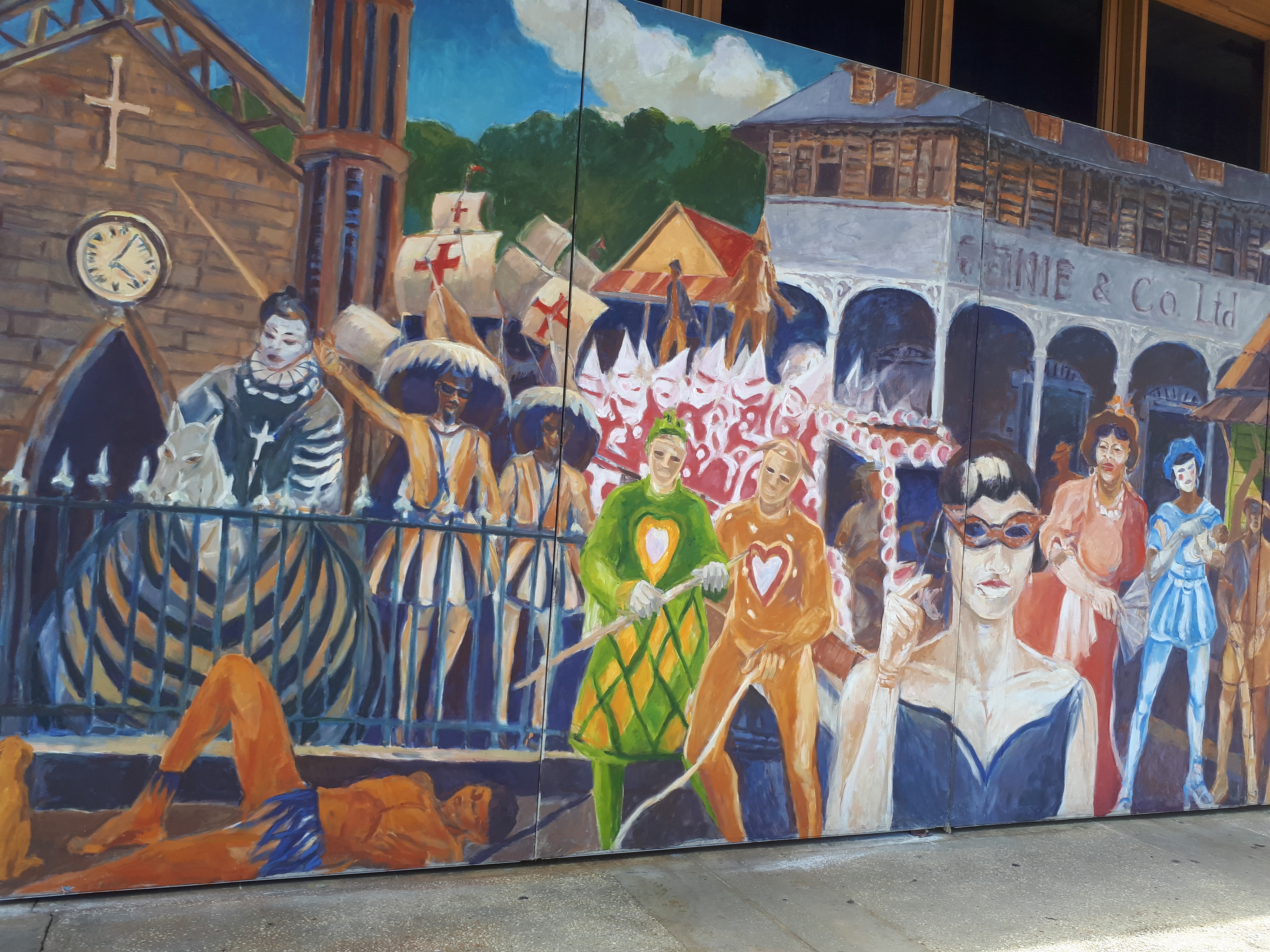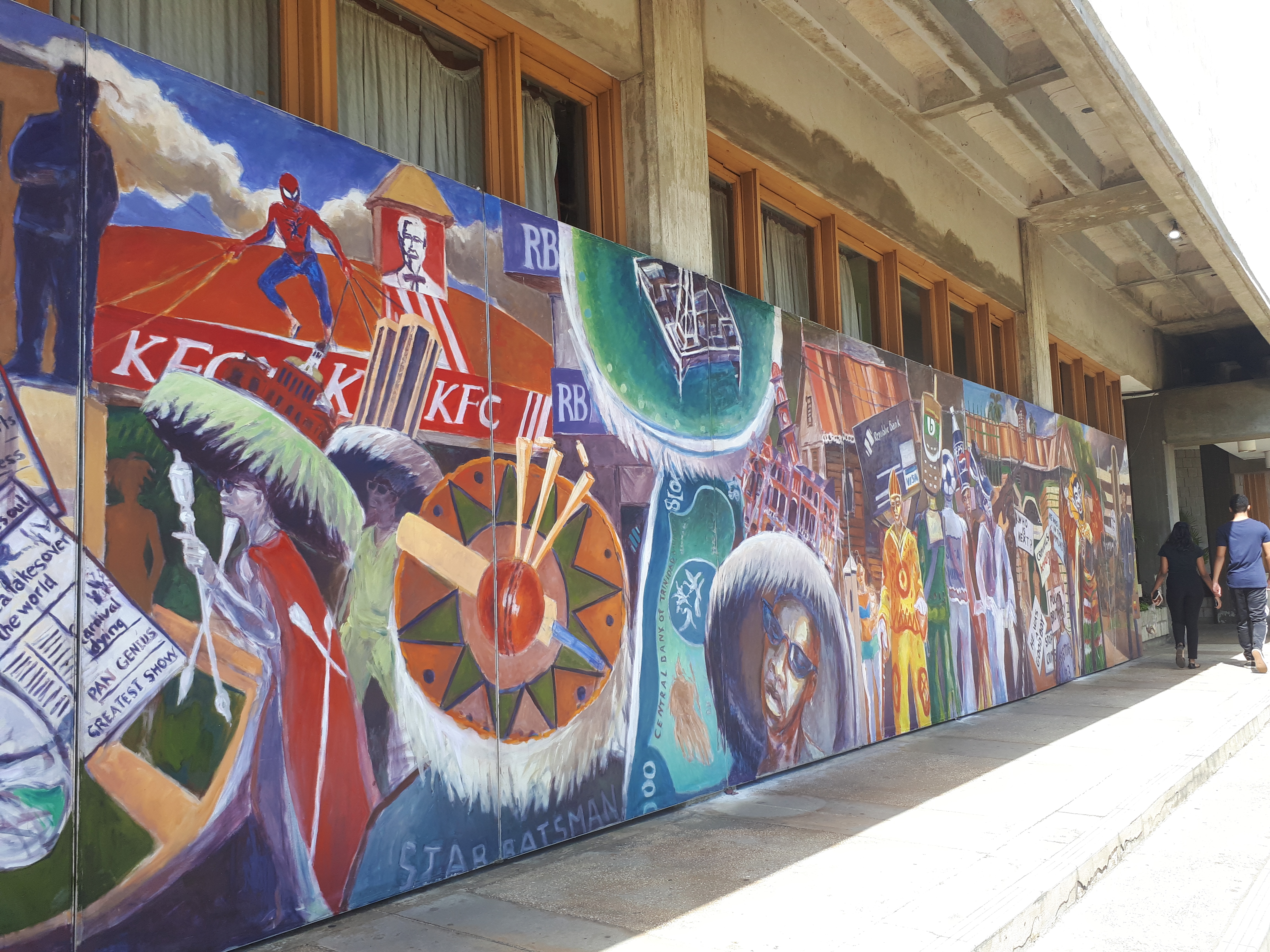Have you ever been so moved by a painting that you teared up?
I walked into my University one day to see a massive exhibition of 22 canvases stretching along the length of our library. In a massive open space with little green and an old, ugly building, it immediately caught my eye with the burst of colour and movement. I stood in that scorching sunlight, not feeling heat but rather intense emotions I couldn’t name bursting inside me and brimming at my eyes. And somehow, the first thing I saw in the frenzy was: Resistance.

at the front of the Alma Jordan Library, UWI St. Augustine
For a student of the University of the West Indies, this meant a lot. Last year in order to protest against the poor security on campus, there was an angry and passionate protest that landed headlines of the three major national newspaper companies and was the talk of the nation – until floods devastated parts of the country, and almost everyone seemed to forget. Except us, of course.
Seeing the painting made me think that despite the crude course of history where nothing really changes, something was being done to upkeep our spirits as students with the entire legacy of Trinidad and the Caribbean with us. The idea was beautiful, and my heart was so filled with gratitude that I willingly let myself get burnt by the sun.
(I was to learn afterwards that this was not the original point of what was apparently, only a temporary exhibit for the Carnival season. But, onwards).
The mural shows the history of Trinidad and the inception and development of nationwide issues as the artist saw them: Jackie Hinkson is to say the least, a “quintessential Caribbean Artist” as stated in his website.
At the end of the week he gave a talk that I, so moved by the piece and devastated that it was only temporary, eagerly attended.

Image courtesy the Visual Arts Unit, Department of Creative and Festival Arts, UWI, St. Augustine.
The event was attended by a small but vibrant and opinionated arts community, students from the Department of Creative and Festival Arts, and myself, from the Department of Literary, Cultural and Communication Studies. From the time I walked into the cozy, dimly lit room I felt it in the air – the confident, refined, and critical atmosphere that emanates from creative people who are in full appreciation of their work and ideas. The talk began with Mr. Hinkson’s idea behind the mural. And when asked about his message to society, he laughed.
“There is a nonspecific message,” he said simply. “It’s simply a work of art, and it’s there for the public. Everyone brings their own baggage to art.”





Isn’t it powerful?
On one of the many occasions I stood staring, a friend approached and I explained the transition as I saw it. And to my delight he complained, “But I’m not seeing anything changing! It all just looks the same!” This was also something I had originally thought. Does anything ever really change? Perhaps, they’re always just the same issues that arise, even though the masks change; “Masquerade” shows that beautifully.
There were many issues raised during the conversation with Jackie Hinkson, and the most prominent of them all addressed the lack of attention and appreciation to arts in Trinidad. The room itself was small and although it was filled, it still was a small room. Why is it, they questioned, that the general public don’t appreciate the arts in Trinidad the way people in other countries do, and why are there so few arts students?
Mr. Hinkson put forward a point. His art isn’t simply about pretty-looking paintings, but depictions of issues that he thinks about. It makes people feel uncomfortable – perhaps if it was more decorative, there would be more corporate and general interest. People want to see pretty paintings, but that isn’t what life, and what Trinidad is solely about. Someone in the audience talked about this corporate interest, citing the lack of space to not buying art pieces. Buildings here are not designed to accommodate pieces, which can be quite large.
And the plight of a graduate with an art degree is real. Never mind that job prospects across all fields are so few now – but people always seem to believe that Humanities graduates – particularly art graduates – can’t possibly get jobs, and it’s true that Trinidadian society is a harsh place for artists to thrive the way they should.
Mr. Hinkson finished the night by talking about Derek Walcott’s question to him whenever they met. “Are you working?” Walcott always asked him. Because despite the lack of attention and appreciation that artists and artists in Trinidad are faced with sometimes, it’s their passion and something they absolutely need to do. Despite the push towards other academics, art is necessary. Artists must be prepared to meet the challenges and work for the rest of their lives. Art really is something that connects and keeps people together, and reminds us of the beauty of the world and humanity, and allows us to be critical of the ugly parts, too. It’s something that asks us to think and makes us feel, regardless of our backgrounds.
There should be more people from different fields at events such as these, because there were so many things said that night that people from all disciples could benefit from. Art has such a magnificent power that is so often taken for granted. Events like this pass and few care. People pass the mural and other paintings and without knowing how to stop and consider it, because our education system doesn’t encourage that kind of sensitivity and criticism until secondary education, when it’s already too late for many. And too few writings are done here on art. These dialogues need to change. Maybe like in the painting, they won’t really, and the dark cloud will always hover there around the corner.
But again, art is what we make it. The fact that I’m here writing, that a single Geography student contributed to the discussion that night, and that you too are here reading this means that the cloud doesn’t have to always exist. Things may not change in the grand picture, but there will always be people who think differently – and that to me, makes a huge difference.
Cover photo courtesy the Visual Arts Unit, Department of Creative and Festival Arts, UWI, St. Augustine.